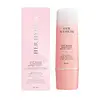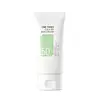What's inside
What's inside
 Key Ingredients
Key Ingredients

 Benefits
Benefits

 Concerns
Concerns

No concerns
 Ingredients Side-by-side
Ingredients Side-by-side

Water
Skin ConditioningButyl Methoxydibenzoylmethane
UV AbsorberOctocrylene
UV AbsorberTitanium Dioxide
Cosmetic ColorantEthylhexyl Salicylate
UV AbsorberZinc Oxide
Cosmetic ColorantGlycine Soja Phytoplacenta Extract
Skin ConditioningGlycerin
HumectantPhospholipids
Skin ConditioningGlycereth-26
HumectantAluminum Hydroxide
EmollientHydroxyethyl Urea
HumectantNiacinamide
SmoothingRoyal Jelly
Butylene Glycol
Humectant1,2-Hexanediol
Skin ConditioningLecithin
EmollientHydrogenated Lecithin
EmulsifyingDipotassium Glycyrrhizate
HumectantChamaecyparis Obtusa Leaf Extract
Skin ConditioningPotassium Olivoyl PCA
CleansingCeramide NP
Skin ConditioningTromethamine
BufferingGalactoarabinan
Caprylyl Glycol
EmollientHydroxypropyl Cyclodextrin
MaskingMelatonin
AntioxidantAdenosine
Skin ConditioningSodium Hyaluronate
HumectantPhenoxyethanol
PreservativeEthylhexylglycerin
Skin ConditioningWater, Butyl Methoxydibenzoylmethane, Octocrylene, Titanium Dioxide, Ethylhexyl Salicylate, Zinc Oxide, Glycine Soja Phytoplacenta Extract, Glycerin, Phospholipids, Glycereth-26, Aluminum Hydroxide, Hydroxyethyl Urea, Niacinamide, Royal Jelly, Butylene Glycol, 1,2-Hexanediol, Lecithin, Hydrogenated Lecithin, Dipotassium Glycyrrhizate, Chamaecyparis Obtusa Leaf Extract, Potassium Olivoyl PCA, Ceramide NP, Tromethamine, Galactoarabinan, Caprylyl Glycol, Hydroxypropyl Cyclodextrin, Melatonin, Adenosine, Sodium Hyaluronate, Phenoxyethanol, Ethylhexylglycerin
Water
Skin ConditioningDibutyl Adipate
EmollientButyloctyl Salicylate
Skin ConditioningPropanediol
SolventEthylhexyl Triazone
UV AbsorberDiethylamino Hydroxybenzoyl Hexyl Benzoate
UV FilterNiacinamide
SmoothingDrometrizole Trisiloxane
UV AbsorberMethylene Bis-Benzotriazolyl Tetramethylbutylphenol
UV FilterGlycerin
Humectant1,2-Hexanediol
Skin ConditioningCaprylyl Methicone
Skin ConditioningPentylene Glycol
Skin ConditioningSphingomonas Ferment Extract
Skin ConditioningCentella Asiatica Leaf Extract
Skin ConditioningFicus Carica Fruit Extract
HumectantCentella Asiatica Extract
CleansingCentella Asiatica Root Extract
Skin ConditioningHydrogenated Lecithin
EmulsifyingVp/Eicosene Copolymer
Decyl Glucoside
CleansingDimethicone/Vinyl Dimethicone Crosspolymer
Skin ConditioningSodium Polyacryloyldimethyl Taurate
Emulsion StabilisingDimethiconol
EmollientTrisiloxane
Skin ConditioningPolyacrylate Crosspolymer-6
Emulsion StabilisingHydroxypropyl Methylcellulose Stearoxy Ether
Ethylhexylglycerin
Skin ConditioningAdenosine
Skin ConditioningSodium Stearoyl Glutamate
CleansingSodium Polyacrylate
AbsorbentCitric Acid
BufferingXanthan Gum
EmulsifyingPolyether-1
Madecassoside
AntioxidantBetaine
HumectantAllantoin
Skin ConditioningPanthenol
Skin ConditioningTocopherol
AntioxidantAsiaticoside
AntioxidantMadecassic Acid
Skin ConditioningMethylpropanediol
SolventAsiatic Acid
Skin ConditioningButylene Glycol
HumectantCeramide NP
Skin ConditioningWater, Dibutyl Adipate, Butyloctyl Salicylate, Propanediol, Ethylhexyl Triazone, Diethylamino Hydroxybenzoyl Hexyl Benzoate, Niacinamide, Drometrizole Trisiloxane, Methylene Bis-Benzotriazolyl Tetramethylbutylphenol, Glycerin, 1,2-Hexanediol, Caprylyl Methicone, Pentylene Glycol, Sphingomonas Ferment Extract, Centella Asiatica Leaf Extract, Ficus Carica Fruit Extract, Centella Asiatica Extract, Centella Asiatica Root Extract, Hydrogenated Lecithin, Vp/Eicosene Copolymer, Decyl Glucoside, Dimethicone/Vinyl Dimethicone Crosspolymer, Sodium Polyacryloyldimethyl Taurate, Dimethiconol, Trisiloxane, Polyacrylate Crosspolymer-6, Hydroxypropyl Methylcellulose Stearoxy Ether, Ethylhexylglycerin, Adenosine, Sodium Stearoyl Glutamate, Sodium Polyacrylate, Citric Acid, Xanthan Gum, Polyether-1, Madecassoside, Betaine, Allantoin, Panthenol, Tocopherol, Asiaticoside, Madecassic Acid, Methylpropanediol, Asiatic Acid, Butylene Glycol, Ceramide NP
 Reviews
Reviews

Ingredients Explained
These ingredients are found in both products.
Ingredients higher up in an ingredient list are typically present in a larger amount.
1,2-Hexanediol is a synthetic liquid and another multi-functional powerhouse.
It is a:
- Humectant, drawing moisture into the skin
- Emollient, helping to soften skin
- Solvent, dispersing and stabilizing formulas
- Preservative booster, enhancing the antimicrobial activity of other preservatives
Adenosine is in every living organism. It is one of four components in nucleic acids that helps store our DNA.
Adenosine has many benefits when used. These benefits include hydrating the skin, smoothing skin, and reducing wrinkles. Once applied, adenosine increases collagen production. It also helps with improving firmness and tissue repair.
Studies have found adenosine may also help with wound healing.
In skincare products, Adenosine is usually derived from yeast.
Learn more about AdenosineButylene Glycol (or BG) is used within cosmetic products for a few different reasons:
Overall, Butylene Glycol is a safe and well-rounded ingredient that works well with other ingredients.
Though this ingredient works well with most skin types, some people with sensitive skin may experience a reaction such as allergic rashes, closed comedones, or itchiness.
Learn more about Butylene GlycolCeramide NP is a type of ceramide and formally known as ceramide 3.
Ceramides are intercellular lipids naturally found in our skin that bonds dead skin cells together to create a barrier. They are known for their ability to hold water and thus are a great ingredient for dry skin.
Ceramides are an important building block for our skin barrier. A stronger barrier helps the skin look more firm and hydrated. By bolstering the skin ceramides act as a barrier against irritating ingredients. This can help with inflammation as well.
If you would like to eat ceramides, sweet potatoes contain a small amount.
Read more about other common types of ceramides here:
Ceramide AP
Ceramide EOP
Ethylhexylglycerin (we can't pronounce this either) is commonly used as a preservative and skin softener. It is derived from glyceryl.
You might see Ethylhexylglycerin often paired with other preservatives such as phenoxyethanol. Ethylhexylglycerin has been found to increase the effectiveness of these other preservatives.
Glycerin is already naturally found in your skin. It helps moisturize and protect your skin.
A study from 2016 found glycerin to be more effective as a humectant than AHAs and hyaluronic acid.
As a humectant, it helps the skin stay hydrated by pulling moisture to your skin. The low molecular weight of glycerin allows it to pull moisture into the deeper layers of your skin.
Hydrated skin improves your skin barrier; Your skin barrier helps protect against irritants and bacteria.
Glycerin has also been found to have antimicrobial and antiviral properties. Due to these properties, glycerin is often used in wound and burn treatments.
In cosmetics, glycerin is usually derived from plants such as soybean or palm. However, it can also be sourced from animals, such as tallow or animal fat.
This ingredient is organic, colorless, odorless, and non-toxic.
Glycerin is the name for this ingredient in American English. British English uses Glycerol/Glycerine.
Learn more about GlycerinHydrogenated Lecithin is created from the hydrogenation of lecithin (a group of phospholipids). Hydrogenation is a chemical reaction between hydrogen and another element.
This ingredient is an emollient and emulsifier. As an emollient, it helps soften skin by trapping moisture within. As an emulsifier, it prevents oil and water ingredients from separating.
Niacinamide is a multitasking form of vitamin B3 that strengthens the skin barrier, reduces pores and dark spots, regulates oil, and improves signs of aging.
And the best part? It's gentle and well-tolerated by most skin types, including sensitive and reactive skin.
You might have heard of "niacin flush", or the reddening of skin that causes itchiness. Niacinamide has not been found to cause this.
In very rare cases, some individuals may not be able to tolerate niacinamide at all or experience an allergic reaction to it.
If you are experiencing flaking, irritation, and dryness with this ingredient, be sure to double check all your products as this ingredient can be found in all categories of skincare.
When incorporating niacinamide into your routine, look out for concentration amounts. Typically, 5% niacinamide provides benefits such as fading dark spots. However, if you have sensitive skin, it is better to begin with a smaller concentration.
When you apply niacinamide to your skin, your body converts it into nicotinamide adenine dinucleotide (NAD). NAD is an essential coenzyme that is already found in your cells as "fuel" and powers countless biological processes.
In your skin, NAD helps repair cell damage, produce new healthy cells, support collagen production, strengthen the skin barrier, and fight environmental stressors (like UV and pollution).
Our natural NAD levels start to decline with age, leading to slower skin repair, visible aging, and a weaker skin barrier. By providing your skin niacinamide, you're recharging your skin's NAD levels. This leads to stronger, healthier, and younger looking skin.
Another name for vitamin B3 is nicotinamide. This vitamin is water-soluble and our bodies don't store it. We obtain Vitamin B3 from either food or skincare. Meat, fish, wheat, yeast, and leafy greens contain vitamin B3.
The type of niacinamide used in skincare is synthetically created.
Learn more about NiacinamideWater. It's the most common cosmetic ingredient of all. You'll usually see it at the top of ingredient lists, meaning that it makes up the largest part of the product.
So why is it so popular? Water most often acts as a solvent - this means that it helps dissolve other ingredients into the formulation.
You'll also recognize water as that liquid we all need to stay alive. If you see this, drink a glass of water. Stay hydrated!
Learn more about Water